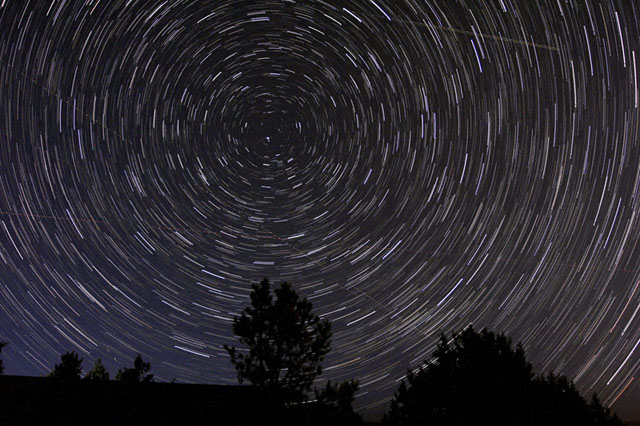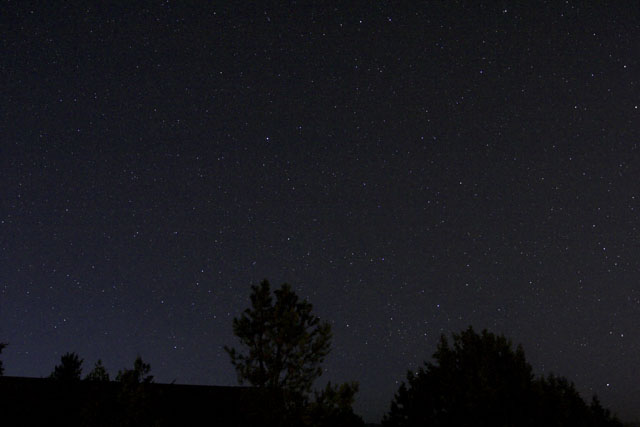
Select an image size for a larger view: 800 x 600 1200 x 800 1600 X 1200 Instrument: 17-40mm L @ 17mm f/4 Platform: Bogen Tripod Camera: Canon 10D @ ISO1600 Exposure: 50m Filters: UV Location: Payson, Arizona Elevation: 5150ft. Sky: Seeing 6/10, Transparency 8/10 Outside Temperature: 50F Processing Tools: Photoshop CS, Pixmantec RAW HOME GALAXIES EMISSION NEBS REFLECTION NEBS COMETS GLOBULARS OPEN CLUST PLANETARIES LINKS
This surrealistic scene might as well be a search sequence for aircraft trails. Dozens of them show up in this long cumulative exposure, composed of 100 frames of 30 seconds each. The earths rotation in only 50 minutes is readily seen here.
Taking the image
In the old film days, we simply put the camera on Bulb, and used a cable release and left it for hours on end exposing the night skies movements. Today, it is done quite differently as I will explain here. Because the camera requires a dark frame for each exposure made over a few seconds with a DSLR, shooting star trails becomes not one long exposure, but a series of shorter exposures combined to form the equivalent image time. While I could have easily gone a 50 minute exposure with my 10d with no problems, another 50 minute dark frame would have to follow to be later subtracted to form the final image. But here I tried something very different.
I learned from some of the DSLR forums that if you put your camera in burst mode, such that it takes photos continuously as you hold the button down for say sports images, or birds taking off - and then put the exposure in manual mode and the exposure set for 30 seconds (the maximum for the dial on the camera), it would "burst" the 30 second exposures and have enough time to save them to the card between shots. Thus the camera shoots for hours on end all by itself by simply locking the shutter button down with an (electronic) cable release. The applications here are such that I can point my camera north, open up the lens and start bursting 30 second frames to make hundreds of snap shots of the polar rotation unattended.
A few nights ago I tried this for the first time, and it worked great. I could have even thrown in a few 30s dark frames at the end if I wished.
The RAW images were converted to TIffs with Pixmantec Raw converter, and by setting the middle shots color balance for all of them automatically, the images were nearly identical. But that was the easy part. Since I can only open about 4 or 5 frames of this 36Mb size up at once in Photoshop to stack them. We had a problem! I had 100 shots, each 36mb each to assemble. After a bit, I put together a Photoshop "Action", which opened up each image, copied them, closed them and stacked and flattened the pasted copy onto another image that stayed on the screen the whole time. By batch processing, the action ran on all 100 images and stacked them one at a time on to the black blank master, combined them with lighten on the layers and then flattened.
The result was hours in coming, a very slow process for so many huge files! By combining with lighten, the above image was made, creating a stunning star trails sequence with no gaps in the stars seen.
The final image was normally processed with a gamma stretch and curves black point. Here is a single 30s frame to compare:
Polaris is just to the left of center, and the head of Draco upper right.

FastCounter by bCentral

